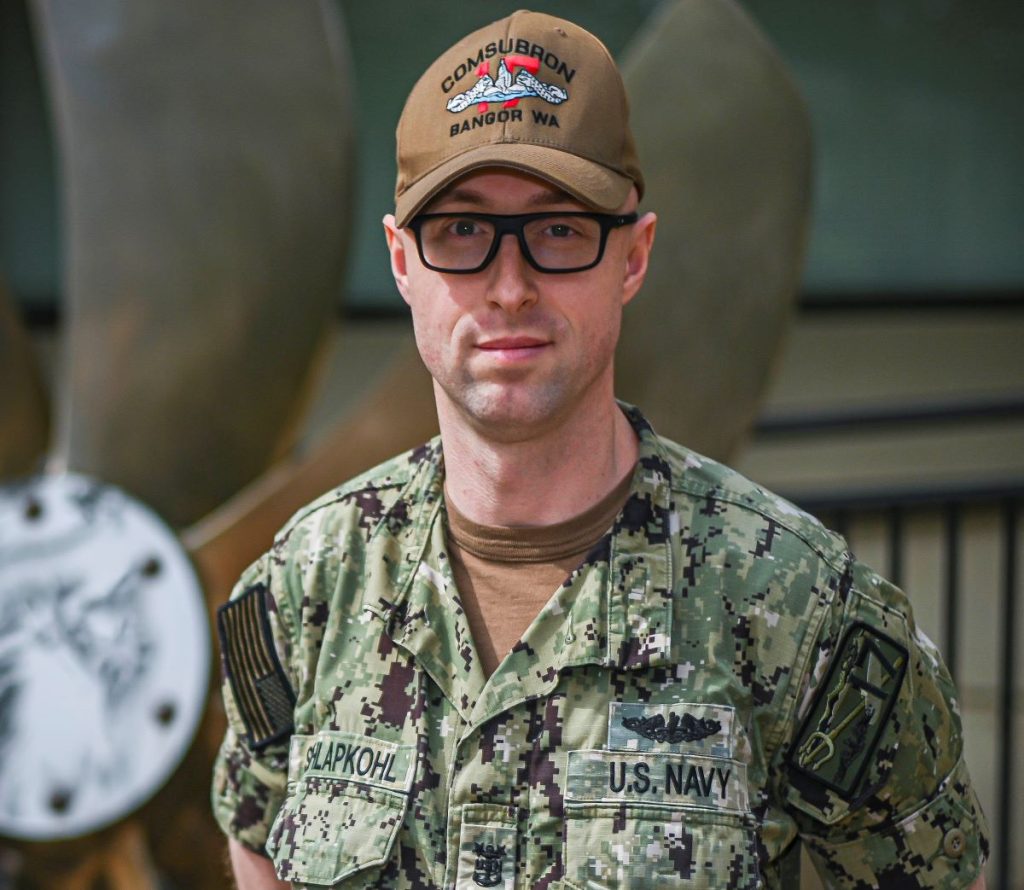By Mass Communication Specialist 1st Class Bryan Niegel
Navy Office of Community Outreach
BANGOR, Wash. – A Elgin, Illinois, native is stationed at Naval Base Kitsap (NBK), homeport to “America’s “Apex Predators,” west coast ballistic-missile and guided-missile submarines.
Master Chief Petty Officer Brian Schlapkohl serves as a machinist’s mate and joined the Navy for military tradition.
“There are a lot of members of my family who served in the military, both my parents served in the Army,” said Schlapkohl. “When I decided to join the Navy my parents asked me why I didn’t join the Army, I told them I didn’t want to sleep in a tent and I wanted to eat good food.”
Schlapkohl attended Elgin High School and graduated in 1998. Today, Schlapkohl uses skills and values similar to those found in Elgin
“I spent a lot of time with the American Legion and The Boy Scouts,” said Schlapkohl “I took away a healthy level of dedication from these experiences.”
These lessons have helped Schlapkohl while serving aboard Commander, Submarine Squadron 17.
“We support national defense because we can strike any target at any time, and from anywhere on the planet,” said Schlapkohl.
Known as America’s “Apex Predators,” the Navy’s submarine force operates a large fleet of technically-advanced vessels. These submarines are capable of conducting rapid defensive and offensive operations around the world, in furtherance of U.S. national security.
There are three basic types of submarines: fast-attack submarines (SSN), ballistic-missile submarines (SSBN) and guided-missile submarines (SSGN).
Fast-attack submarines are designed to hunt down and destroy enemy submarines and surface ships; strike targets ashore with cruise missiles; carry and deliver Navy SEALs; conduct intelligence, surveillance, and reconnaissance missions; and engage in mine warfare. The Virginia-class SSN is the most advanced submarine in the world today. It combines stealth and payload capability to meet Combatant Commanders’ demands in this era of strategic competition.
The Navy’s ballistic-missile submarines, often referred to as “boomers,” serve as a strategic deterrent by providing an undetectable platform for submarine-launched ballistic missiles. SSBNs are designed specifically for stealth, extended patrols and the precise delivery of missiles. The Columbia-class SSBN will be the largest, most capable and most advanced submarine produced by the U.S. – replacing the current Ohio-class ballistic-missile submarines to ensure continuous sea-based strategic deterrence into the 2080s.
Guided-missile submarines provide the Navy with unprecedented strike and special operation mission capabilities from a stealthy, clandestine platform. Each SSGN is capable of carrying 154 Tomahawk cruise missiles, plus a complement of heavyweight torpedoes to be fired through four torpedo tubes.
Strategic deterrence is the Nation’s ultimate insurance program, according to Navy officials. As a member of the submarine force, Schlapkohl is part of a rich 122-year history of the U.S. Navy’s most versatile weapons platform, capable of taking the fight to the enemy in the defense of America and its allies.
Serving in the Navy means Schlapkohl is part of a team that is taking on new importance in America’s focus on rebuilding military readiness, strengthening alliances and reforming business practices in support of the National Defense Strategy.
“We support national defense because we can strike any target at any time, and from anywhere on the planet,” said Schlapkohl.
With more than 90 percent of all trade traveling by sea, and 95 percent of the world’s international phone and internet traffic carried through underwater fiber optic, Navy officials continue to emphasize that the prosperity and security of the United States is directly linked to a strong and ready Navy.
A major component of that maritime security is homeported at Naval Submarine Base Bangor.
Strategic deterrence is the nation’s ultimate insurance program, and for decades Naval Submarine Base Bangor has been home to Ohio Class ballistic-missile submarines. Beginning in 2028, the new Columbia Class ballistic-missile submarines will arrive and provide continuous sea-based strategic deterrence into the 2080s.
Schlapkohl and the sailors they serve with have many opportunities to achieve accomplishments during their military service.
“I’m most proud of being able to mentor junior sailors,” said Schlapkohl. “I’ve gained the most personal satisfaction from seeing the most junior unmotivated sailor who needs improvement advance to the rank of chief petty officer.”
As Schlapkohl and other sailors continue to train and perform the missions they are tasked with, they take pride in serving their country in the United States Navy.
“I take a lot of pride with my ability to give back to my community both in and out of the military,” added Schlapkohl.








